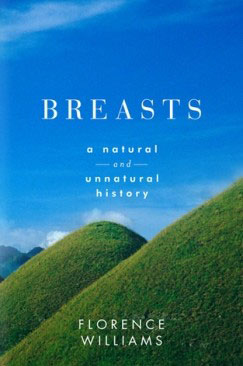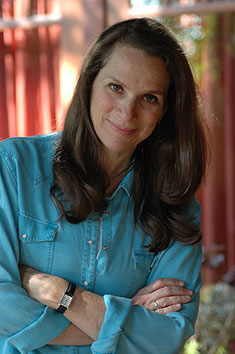
published in the Los Angeles Review of Books
THERE'S NOTHING LIKE STARING at mountains to remind us of breasts — their magnificence, their evolutionary brilliance, their voluptuous tug on our collective psyches. In French Un teton (as in Grand Tetons), means the tip of the breast. So it seems fitting that an intrepid science writer living near the Rocky Mountains in Boulder, Colorado was inspired to undertake the time and effort required to produce such an important piece of reportage as Florence Williams has done with Breasts: A Natural and Unnatural History.
Seven years ago, just as she was blissfully nursing her second child, Williams read a series of reports about industrial chemicals winding up in human breast milk. There went her fantasy that breast milk was like "ice cream, Valium and Ecstasy all wrapped up in two pretty packages." On assignment for the New York Times Magazine, Williams had her own breast milk tested and discovered it had levels of flame retardants — from electronics, furnishings and food — ten to 100 times higher than that of women in Europe. She wanted to know if it was still okay to breast feed at all. And, she wondered, will women ever be able to produce relatively uncontaminated milk again?
With a scientist's mind, a journalist's eye, and a mother's heart, Williams has produced a wide-ranging environmental history of the breast, in which she addresses such questions as: why girls are sprouting breast buds earlier (and facing an increased breast cancer risk as a result), how breasts have gotten bigger since the Second World War, and the chicken-and-egg conundrum of which came first in the evolutionary scheme of things — breasts for succor or breasts to attract males. Williams, a visiting scholar and research fellow in environmental journalism at the University of Colorado, has, in her own words, a "dogged sense of granola-girl duty," and as a result she is a thorough and dependable guide to understanding issues big and small about endocrinology, biology and epigenetics.
"We are not simply agents of environmental change, we are also objects of that change," she explains. "Our breasts soak up pollution like a pair of soft sponges." Williams delineates one of the most consequential dramas at the intersection of human evolution and environmental change, that is, "how our breasts went from being honed by the environment to being harmed by it." According to the CDC, breast cancer is now the most common cancer among women.
¤
While this could obviously be a depressing enterprise, Williams is an accomplished writer with a wicked sense of humor, provocative and insightful. As she points out, the book's publication coincides with the fiftieth anniversary of two seminal events: the publication of Rachel Carson's prophetic environmental primer Silent Spring, along with the first silicone implant surgery in Houston. Carson died of breast cancer in 1964, but Williams tracked down the first silicone implant patient, Timmie Jean Lindsey. In exchange for a cosmetic surgery she didn't want, namely new breasts, Lindsey got one she did want — her ears pinned back — by two plastic surgeons working with Dow Corning. She was, in other words, their human guinea pig. Over time, her implants hardened and caused "shooting pain" in her chest. Most silicone implants last for 10 to 20 years, but Timmie Jean still has the original ones 50 years later. (Though her implants ruptured years ago, she never had them removed because surgery would require cutting away dense scar tissue and calcifications.)
From New Zealand to Peru, from Houston to San Francisco, Williams has traveled the globe to interview medical experts but to also offer unflinching (and often funny) accounts of breast implant surgery, eye-tracker research that observes men observing boobs, and what it means to biopsy her furniture to figure out where those nasty flame-retardants in her breast milk are coming from. Since breasts have become "industrial mirrors" — they accumulate more toxins than any other organ, thanks to fat content — Williams provides a great public service, interpreting data and telling a modern-day story that is at once profound and deeply disturbing: if we miraculously cleaned up our planet tomorrow of all the toxins from the last century, the effects would last three generations.
But Williams has the good sense to go beyond sounding alarms, which is what makes this such a compelling read. Even the front cover art, depicting two inviting green hillsides, and the back cover of the giant concrete San Onofre containment domes with their nipple-like tops, slyly remind us how nature and engineering design can make something as ominous as nuclear power seem downright familiar and even benign, given our powerful associations with breasts. Somehow Mom, apple pie, and nuclear fission all got wrapped up in the same package.
In terms of evolution, Williams links all human capability to the bosom. "Breasts are us," she writes, pointing out that, thanks to nipples, there was a reason for lips. Not to mention a palate for speech and language. Lest we forget: breasts begat kissing, too. Humans are categorized as mammals due, in large measure, to breasts, which evolved from sweat glands and led to our domination over dinosaurs. Still, there is no way of knowing precisely when "the well-endowed rack," as Williams writes, appeared in human evolution — before bipedalism or after we lost our fur? She answers this way: "Pretty much all the theories accounting for breasts are best categorized as SWAG, scientific wild-ass guesses."
For much of Western history, large breasts were considered a handicap. So why have we come to associate big, fake breasts with sexiness? And how much of that association was marketed to us like so many chemical amelioratives of the past 40 years? Williams takes us on a wild ride to answer that question, starting at Ground Zero for cosmetic breast enhancement: Houston, which correspondingly became the strip-club capital of the world. Of course, Carol Doda and her "new Twin Peaks of San Francisco," insured for $1.5 million, would also hold a starring role. Long before Doda's silicone injections, Williams writes, implants materials included "glass balls, ivory, wood chips, peanut oil, honey, goat's milk and ox cartilage."
"Women going to dangerous extremes for beauty is not new," she observes. "For a thousand years Chinese women crippled themselves and their daughters to have tiny, deformed feet. Western women literally suffocated while wearing corsets, some of which punctured their internal organs. Women have painted their faces with lead and arsenic and ripped their body hair off with hot wax. Oh, wait, we still do that."
The cautionary tale of how the technology to alter women's bodies would trump consumer protection is a sad one, indeed. After 1992, during a brief government moratorium, the number of women receiving implants in the U.S. plummeted from 150,000 to 30,000 annually. By 2007, a year after the FDA approved the next generation of silicone implants (a gel in a baggie), the figure had increased nearly 1,000 per cent. There are now five to ten million American women with implants. "After a 14-year hiatus," she writes, "the fake boob industrial complex was fully back in business."
Though implant manufacturer Dow Corning would declare bankruptcy in 1995 and enter into a $3.2 billion settlement with 170,000 women — the largest class-action settlement at the time — Williams reports that after two decades of study, science has not backed up most claims of mysterious immune-system ailments linked to ruptured plastic implants. Instead, she writes, the FDA cautioned in 2011 that implant patients have high rates of a very rare cancer, anaplastic large-cell lymphoma, which grows in the cells of scar tissue surrounding the implant. Further, implant patients don't have higher rates of breast cancer but they do have higher rates of lung and brain cancer.
The question of what happens to women with breast implants while nursing is uncertain though many women report problems with nipple sensation. Williams writes:
Let's be clear about what these under-sung side effects mean: in a world where breasts are considered purely sexy, we jeopardize the central natural functioning of breasts (lactation and dynamite neural sensation) so that they can be even more sexy, to the point where the improvement actually eliminates the sexual feeling in this allegedly sexy organ. Now we can have hard, lifeless replicas of something sexy.
And yet, even with their ruptures and repeated surgeries and lifeless nipples, most women still say they are happy with their implants. Given reports of improved self-esteem and self-confidence, Williams writes, "this makes some kind of sense" since the brain is the body's largest sex organ.
¤
I learned so much from this book that I'm embarrassed to admit how much I didn't know. Breast-feeding, the intimate act of love and nurture, is also a source of competition between mother and infant. Evolutionary biologists call it matrotropy, or eating one's mother. So, in order to protect a nursing mother's needs, Williams explains, breasts discern the sex of an infant and adapt accordingly: males, because they're bigger, tend to receive fattier milk and females get more milk that's low-fat. Who knew? And I nursed three babies of my own.
Or did you know that the left breast tends to be bigger than the right one? Or that breast volume varies by 13.6 per cent during a monthly cycle, owing to changes in water retention and cell growth? Or that the world's largest set of implants weighed 21 pounds and required a size 38KKK bra? Ouch. And beyond the lingering question of why do men have nipples, Williams points to features of other mammals, like the manatee with nipples under her flippers, the aye-aye of Madagascar with nipples near her butt, and a hedgehog from Madagascar which takes the prize for most nipples, namely 24 of them.
I occasionally wished her editor had roped her in a tad, as in "my knockered preconceptions were knocked upside down" — a sentence she unleashes when she discovers Carol Doda's whereabouts at a lingerie store in San Francisco where she still performs with her band The Lucky Stiffs. (The author expected Doda would be a tenderloin junkie who had died from silicone poisoning but she found her well into her seventies, having lived a "long and rather fabulous life.") Still, Williams is to be commended for conveying the Big Picture. Most important to this reader was the author's contribution to the literature on one the most neglected public health issues of our time: the environmental causes of breast cancer.
¤
Having a mother who died of breast cancer and a sister now battling ovarian cancer, I was especially drawn to Williams's painstaking attention to environmental links to breast cancer, an area of research that gets shafted in federal grant dollars. Since family history only accounts for about 10 per cent of breast cancers, and the wealthiest countries have the highest rates of breast cancer worldwide, something else is going on. "And that something else is linked to modern life from the furniture we sit on to our reproductive choices, to the pills we take, to the foods we eat.
Williams demands answers to key questions: Why is mammography such a flawed technology that has barely improved in 50 years? Why would the best means of detecting breast cancer also expose women to additional radiation — the only proven environmental cause of breast cancer? "We can invent the Internet but not something better than blasting ions into our boobs using forty pounds of pressure?" she asks rhetorically while also suggesting a reason: There is little money in the breast-cancer-prevention business compared to screening and treatment; the BRCA genetic screening for women with a family history of the disease costs $3,000.
Much as she may try to shield her own family from the onslaught of silent endocrine disruptors by cutting down on canned beverages and foods and being vigilant about throwing away her son's cute foam chair or taping up the tattered upholstery in her husband's old pick-up, Williams comes to understand that none of this can be done in any way that really matters until the government and chemical industry change the way these toxins are tested, manufactured and marketed. "We can only eat so much quinoa out of a paper bag," she says.
As Williams's flame-retardant adventures illustrate, the best solution would be a regulatory one. But she cautions us not to hold our collective breath. For the past 30 years, the California chemist Arlen Blum has conducted research on the health hazards of tris, a flame retardant, and watched as the California Legislature has repeatedly failed to pass safety bills about it. Blum, who led the first American climb of Annapurna and walked the Himalayas, told Williams that "both were easier than fighting the chemical industry."
Williams zeroes in on the mind-boggling deficiencies in the U.S. regulatory system concerning chemical safety. Every year, 700 new chemicals come to market in addition to the already existing 82,000 in use. Of these, only a few hundred have ever been tested for health effects — and a whopping five chemicals have ever been banned. In a bizarre inversion of the most cherished aspect of our judicial system, American companies are not required to test for the safety of their products before they're introduced into the marketplace; every chemical is assumed safe until proven guilty. But it takes years of research and countervailing proprietary industrial secrets to prove a chemical causes harm. "Of the 650 top-volume chemicals in use," Williams writes, "four billion pounds get released into the American water and air each year."
And even now, with new, streamlined EPA guidelines to focus on animal testing of suspected endocrine-disrupting chemicals, the tests are geared to focus on endpoints such as the brain, liver, kidney and genitals. "They leave the mammary gland in the trash can," a toxicologist at the Silent Spring Institute in Massachusetts tells Williams. Never mind that more tumors develop in the breast than any other organ or that the mammary gland is the most sensitive organ to known culprits, such as the weed-killer atrazine, which has been banned in Europe and is the most common contaminant of American drinking-water supplies.
Indeed, Williams could have gone even further in her analysis of the politics of breast cancer research and prevention. Following the money would have been one such route. I had hoped, for instance, that she might tackle how the Koch Brothers' empire has impacted research decisions with organizations such as the Susan G. Komen Foundation, the world's largest non-profit dedicated solely to combating breast cancer. The fact that Komen officials have refused to acknowledge the BPA-breast cancer link — despite 130 studies and decades of well-documented animal and cell studies — might well have something to do with the fact that its biggest contributors are BPA manufacturing giants that also happen to be the main bankrollers of America's Tea Party movement.
"Breasts carry the burden of the mistakes we have made in our stewardship of the planet," Williams writes, "and they alert us to them if we know how to look." By knowing how to look, Williams brings pressure to bear on the many companies whose business plans depend on a methodical looking away. If this book is not a game-changer, we have no one to blame but ourselves.
published in the Los Angeles Review of Books



